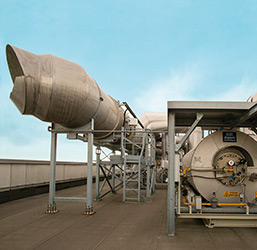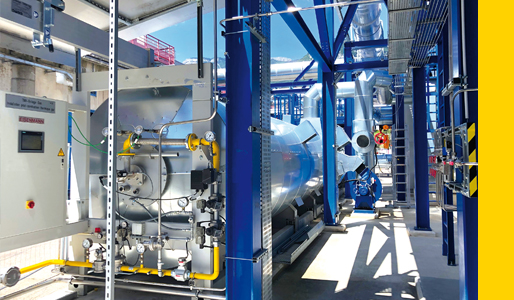Chemicals
Waste & Chemicals
Our Ambition
Strive for zero waste in landfill, reduce our consumption of chemicals and eliminate hazardous materials.
2025 GOAL
95%
of our waste reused and recycled
Responsibly managing the chemical substances and materials used in our operations is critical for protecting people, preserving the environment, and complying with legal and customer requirements.
At each manufacturing site, we take a precautionary approach to guide all decisions related to chemical usage and handling. The site chemical committees regularly meet to evaluate the composition, the hazards and the use conditions of chemical substances and materials. This includes risk management measures, personal protective equipment, waste management and administrative controls. Following this process enables us to identify critical substances as soon as they are introduced or reclassified. I 103-2 I
In 2020, we recorded 5,919 chemicals in use, and we conducted 587 new risk assessments, reaching a total of 30,702 validated risk assessments by the end of the year. I 103-3 I
Caring for our people
Reducing people’s exposure to hazardous chemicals underpins our actions and initiatives at all our manufacturing sites. In 2020, our Ang Mo Kio site (Singapore) worked on a project to reduce handling of small bottles of liquid chemicals by installing a chemical distribution system, while our Crolles site (France) secured the transfer of hazardous reusable liquid by installing new pipelines. Both projects will continue in 2021.
>18,700
industrial hygiene measurements
We can reduce people’s exposure to chemicals not only through equipment upgrades or system changes, but also by redesigning processes. For example, the R&D teams at our Agrate site (Italy) introduced solid substances instead of hazardous liquid chemicals when creating a new generation of piezoelectric material, thereby reducing the risks for people and the environment.
In 2020, the 18,781 industrial hygiene measurements we performed were all below the applicable limits, proving the effectiveness of our preventive actions and continuous attention.
Workers exposed to chemical risks are regularly trained on chemical hazard classification, potential health consequences, emergency and preventive procedures, and risk management measures.
Preserving the environment
Volatile organic compounds (VOCs) are compounds that easily become gases or vapors, some of which may have adverse effects on human health. Reducing VOC air emissions from our operations is therefore essential. We do this by collecting exhaust fumes from equipment that uses chemicals and by treating air emissions in appropriate abatement systems.
In 2020, our Crolles site (France) reduced its VOC emissions by 12% vs 2019 by installing new burners.
In the meantime, our teams in Asia focused their efforts on complying with a Chinese government initiative called ‘Blue Sky’, which aimed to improve air quality by reducing total VOC emissions in 2020 by at least 10% compared to 2015. The project included remediation plans for certain industries and a ban on VOC-containing solvents in several applications and industry sectors. These include the semiconductor industry, which uses adhesives containing hazardous substances in the assembly process. During the year, our Shenzhen site (China) implemented the relevant standards, including compliance test reports, document verification and increased control of VOC emissions (see Focus and quote).

Frankie Agius
Director of Quality, Global Key Accounts, Coppell (USA)
ST, our customers and our suppliers are all stakeholders in the future of our planet, and we have many challenges in front of us. Being able to make a difference is a shared goal for all. We have worked extensively with our supply chain to enhance reporting and tackle the removal of hazardous substances. ST’s hard work and commitment enabled us to successfully meet the objectives of China’s ‘Blue Sky’ VOC program.”

Focus
Supporting China’s ambition for a blue sky
To facilitate its ‘Blue Sky’ program, aimed at improving air quality, the Chinese government published a new standard on VOC emissions in March 2020, which would come into force in December. It sought to classify all adhesives used in assembly manufacturing according to the standard, perform specific tests, and collect compliance documents. This impacted not only ST activities, but also all ST’s subcontracted activities in China.
Haiyan Zeng, HSPM Program Manager at our Shenzhen site (China), and Hui Lin Koh, Global Outsourcing Business Management at our Ang Mo Kio site (Singapore), played a decisive role in the rapid success of ST’s implementation by coordinating actions and checking and centrally archiving compliance documents to provide easy access for our customers and internal teams.
Haiyan also worked in close cooperation with the environment and facility teams at the Shenzhen site to ensure VOC-containing gaseous streams were treated before release into the environment. An audit performed mid-December by a major customer confirmed that our good teamwork was helping to win the battle for a blue sky.
Aligning with expectations
Replacing hazardous substances
95%
PFOA-free
ST’s phase-out of perfluorooctanoic acid (PFOA) related substances achieved a major step forward in 2020, reaching 95%. The Rousset and Crolles sites (France) participated by successfully replacing PFOA-related substances used in their manufacturing process. By the end of the year, only a few process flows remained to be modified and we are on target to reach our objective of being 100% PFOA-free by 2025.
Compliance and reporting
We comply with applicable environmental regulations and requirements, including European chemical policies and directives, such as REACH1, RoHS2, and ELV3.
To effectively recycle raw materials from waste, it is necessary to know if the waste contains hazardous substances. One of the objectives of the European Waste Framework Directive (WFD) is to improve the material recycling ratio from collected waste. In line with this aim, ST declares substances of very high concern, as listed by REACH, contained in any product sold in Europe. In 2020, we adapted data from our existing database to enable us to meet REACH and WFD data reporting requirements. Starting in 2021, all relevant ST products are now declared through a dedicated web portal managed by the European Chemicals Agency.
To provide our customers with information on the chemical composition of our products, we also report and publish our material declarations (available on www.st.com) in accordance with the IPC17524 standard.
Meeting customer expectations
Lab certified
ISO 17025
ST has been working for more than five years on the deployment of Hazardous Substance Process Management (HSPM) to identify, control, quantify and report any hazardous elements in components, according to the CQ080000 standard. The goal is to ensure that the end products comply with customer requirements. In 2020, we strengthened our ability to perform non-disruptive analytical controls on raw materials. At our Shenzhen site (China), we took advantage of a refurbished lab, which achieved ISO 17025 certification during the year, to deploy several methods to detect regulated substances. The results of a site audit conducted by a major customer in 2020 confirmed ST’s compliance with requirements on the presence of hazardous substances in products.
Monitoring our suppliers
We require our suppliers to respect our EHS-regulated substances list, which contains more than 3,000 substances and is regularly reviewed. We also require them to confirm their compliance through analytical certificates, safety datasheets and commitments.
Contributing to the Sustainable Development Goals
Our commitments and programs as described above contribute to:
SDG target 3.9 – Substantially reduce the number of deaths and illnesses from hazardous chemicals and air, water and soil pollution and contamination.
SDG target 6.3 – Improve water quality by reducing pollution, eliminating dumping and minimizing release of hazardous chemicals and materials, halving the proportion of untreated wastewater and substantially increasing recycling and safe reuse globally.
SDG target 12.4 – Achieve the environmentally sound management of chemicals and all wastes throughout their lifecycle, in accordance with agreed international frameworks, and significantly reduce their release to air, water and soil in order to minimize their adverse impacts on human health and the environment.
(1) REACH: Registration, Evaluation, Authorization and Restriction of Chemicals.
(2) RoHS: Restriction of Hazardous Substances.
(3) ELV: End of Life of Vehicles.
(4) IPC1752: Association connecting electronics industries.
2020 OBJECTIVES |
Status |
Comments |
|
In line with World Semiconductor Council (WSC) statement, remove PFOA and PFOA-related substances in all manufacturing chemicals by 2025. |
|
Removed 95% PFOA and PFOA-related substances in 2020 compared to 2014 when the program started. |


